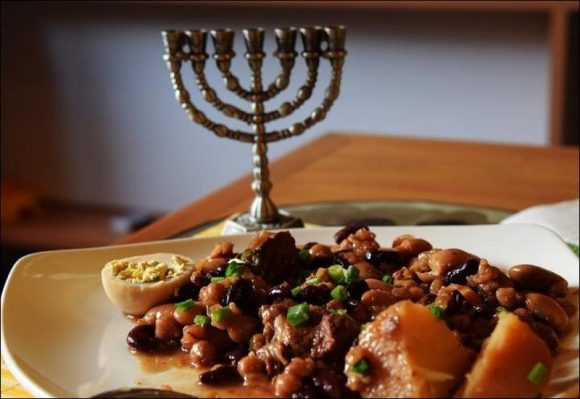Judaism has a very close relationship with food. Most holidays have one or more specific foods associated to it. There are many Jews that observe Jewish dietary laws, like keeping kosher and not cooking on Shabbat. But what’s the history of why some foods are Jewish and some are not? How did Matzo Ball Soup get its name? This video will give you a glimpse into the history of some iconic Jewish foods.
Number Eight. Hamantashen.
It’s the best Jewish cookie. (Not that there’s much competition.) Named for the villain of the Purim story, Haman, who wore a three cornered hat. You can find chocolate, cherry or apricot but the classic hamantash is always filled with poppy seeds.
Number Seven. Potato Latkes.
These are delicious fried potato pancakes that you eat during Chanukah. But let’s be real here. Latkes can be enjoyed any time. It turns out they’re an old Italian Jewish custom from way back in the 14th century. It is told that this is the first time Jews fried pancakes to celebrate Chanukah, only back then they were made of cheese.
Number Six. Matzo Ball Soup.
For many, matzo ball soup is an absolute staple during Passover. Matzo balls were originally called knaidelach, Yiddish for dumpling. As Germans, Austrians, and Alsatian immigrants came to the US in the 30s, the Manischewitz Company released a kosher cookbook describing the now-famous matzo balls as “feathery balls, Alsatian style”. Historians have said it was likely early 20th-century American comedians that finally called them “matzo balls.”
Number Five. Shakshuka.
Served in a iron skillet, this is a hot dish of simmered onions, garlic, bell peppers, tomatoes, spices and with a few eggs dropped on top to cook. Dip a bagel or French bread in this classic Israeli breakfast. Shakshuka was brought to Israel by North African Jews, where it’s a staple thanks to Israel’s large North African Jewish communities.
Number Four. Burekas.
Every culture has its stuffed pastry. In Israel these are called bourekasim and they’re puff pastry stuffed with cheese, potatoes, veggies, meat…whatever floats your boat. These are appetizers and Israeli street food… the perfect portable snack.
Number Three. Jelly Donuts.
Also known as Sufganiyot, which derives from the Hebrew word for sponge, which perfectly describes the way they absorb oil. Best eaten warm, sufganiyot are often topped with powdered sugar and practically melt in your mouth.
Number Two. Cholent.
This is a fan favorite in the observant Jewish world because it’s all about keeping Shabbat and not using electricity to cook on Saturday. Cholent is stew that you set up on Friday afternoon before welcoming Shabbat. You throw in beans, potatoes, garlic, barley, onions, flanken, maybe eggs, maybe jachnun, and then your family’s ultra secret spices or sauces all into the pot and let it cook for…entirely too long. Bust into the cholent on Saturday for lunch after twelve plus hours of it smelling amazing.
Number One. Challah Bread.
Many might think of Challah as that sweet and tasty french toast they had at brunch last Sunday. But actually this beloved, braided egg bread is eaten at Shabbat dinners around the world. Some believe that the braid represents the idea of unity because on every Shabbat, we dedicate time out of our busy lives to come together to feast and rest before the start of a new week.
Views: 371



